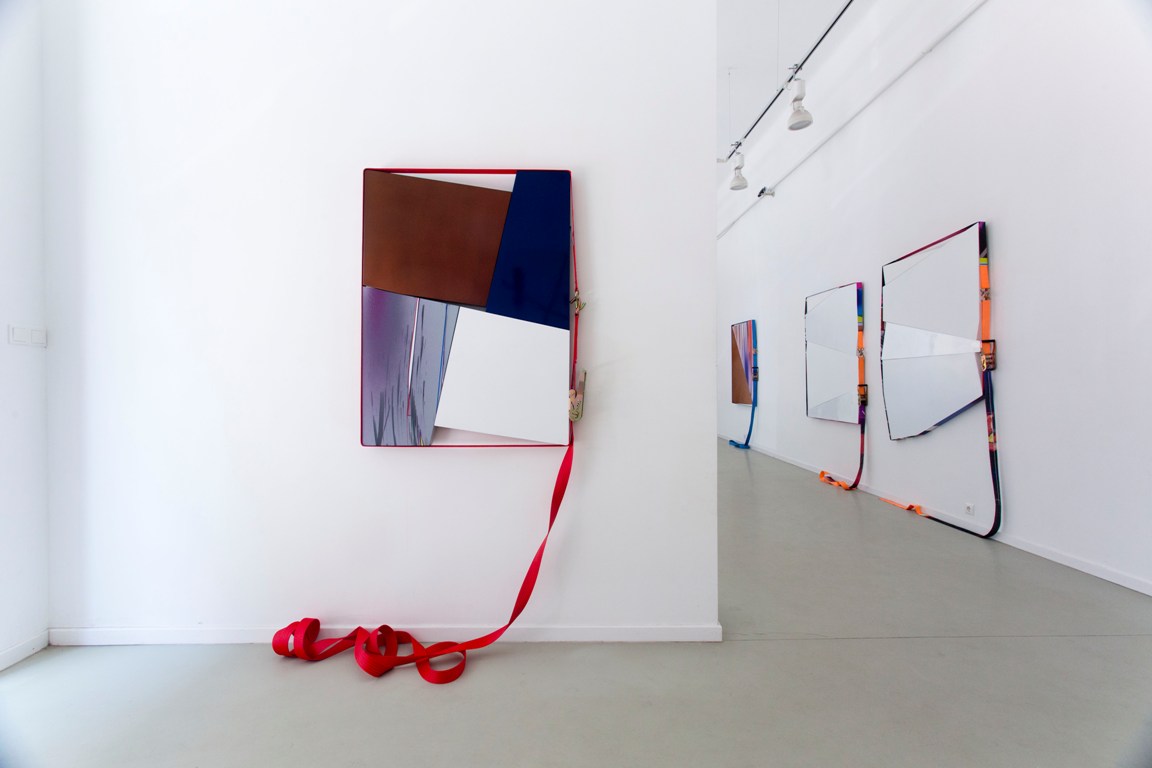
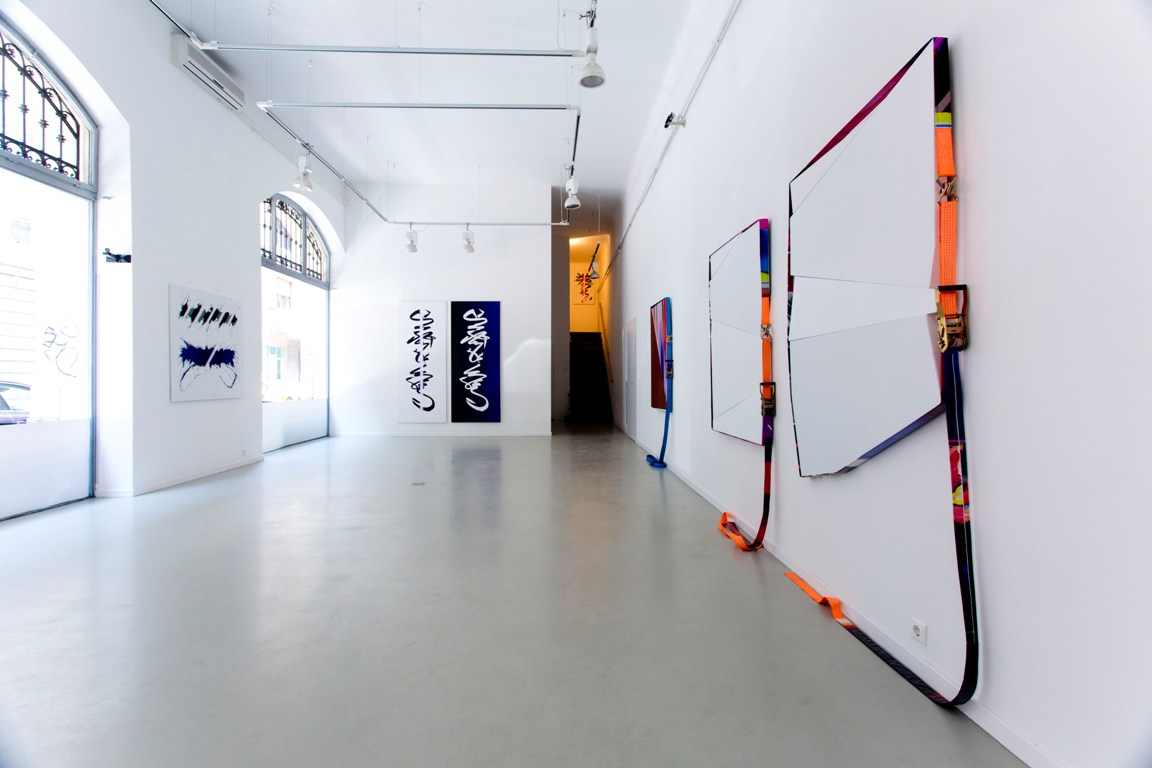
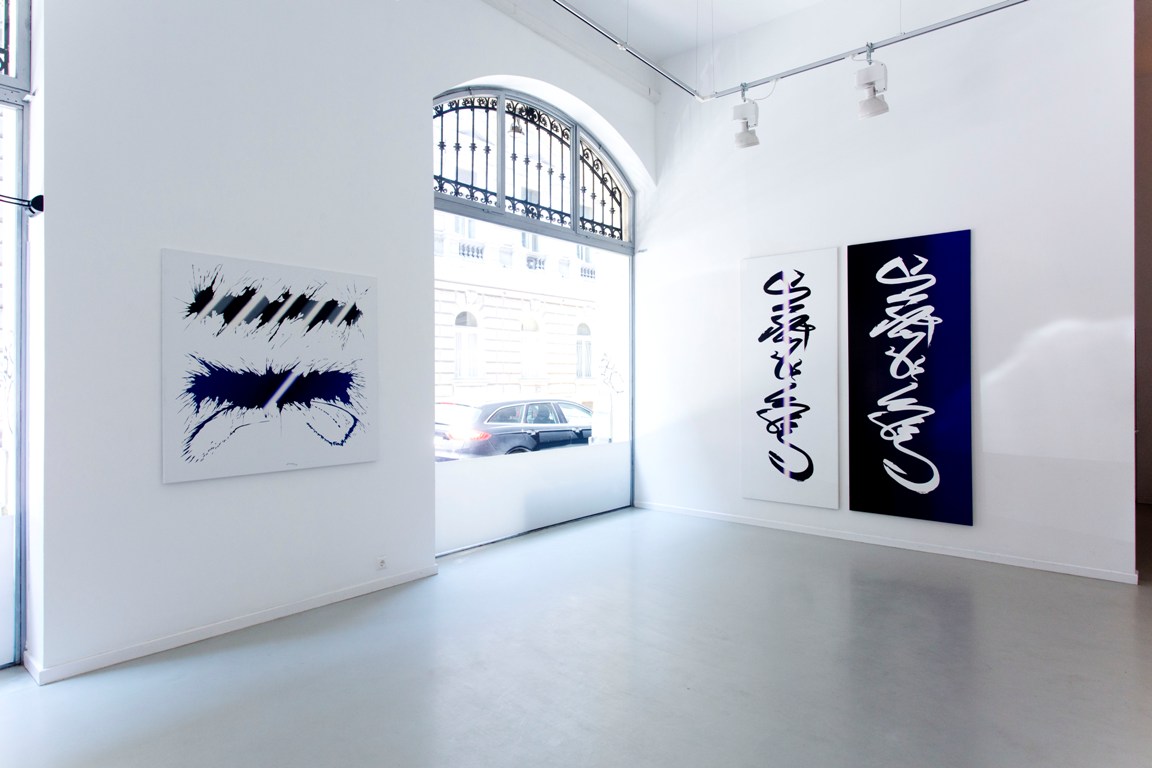

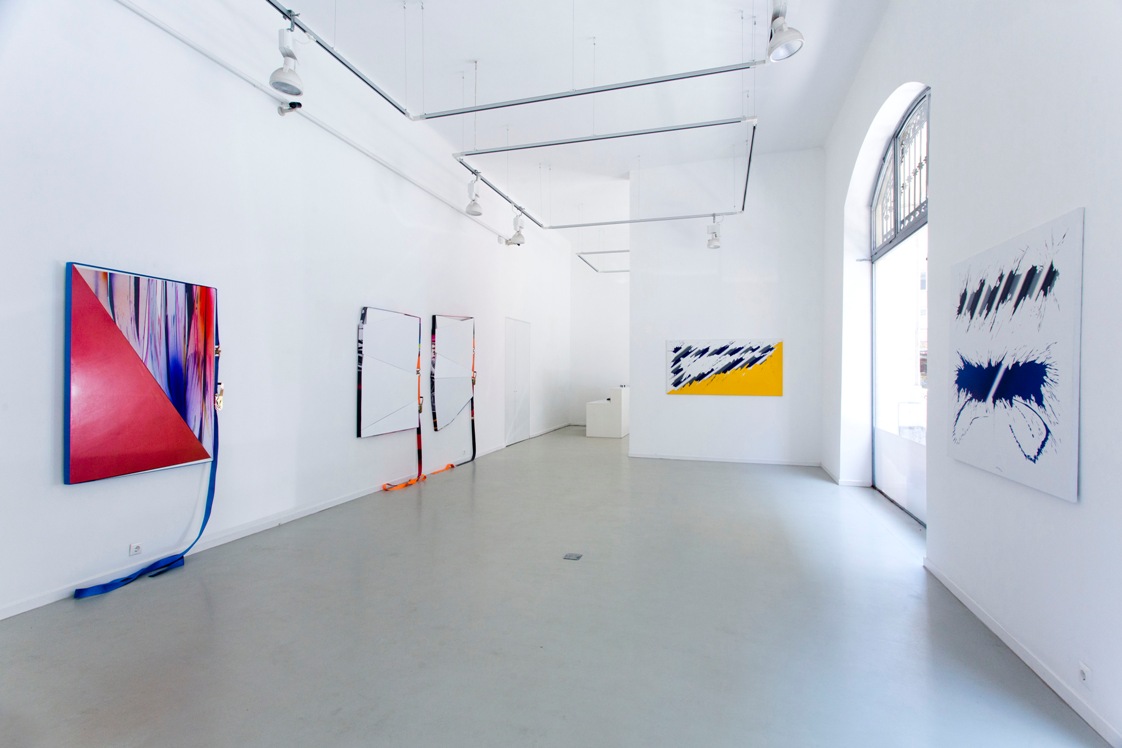
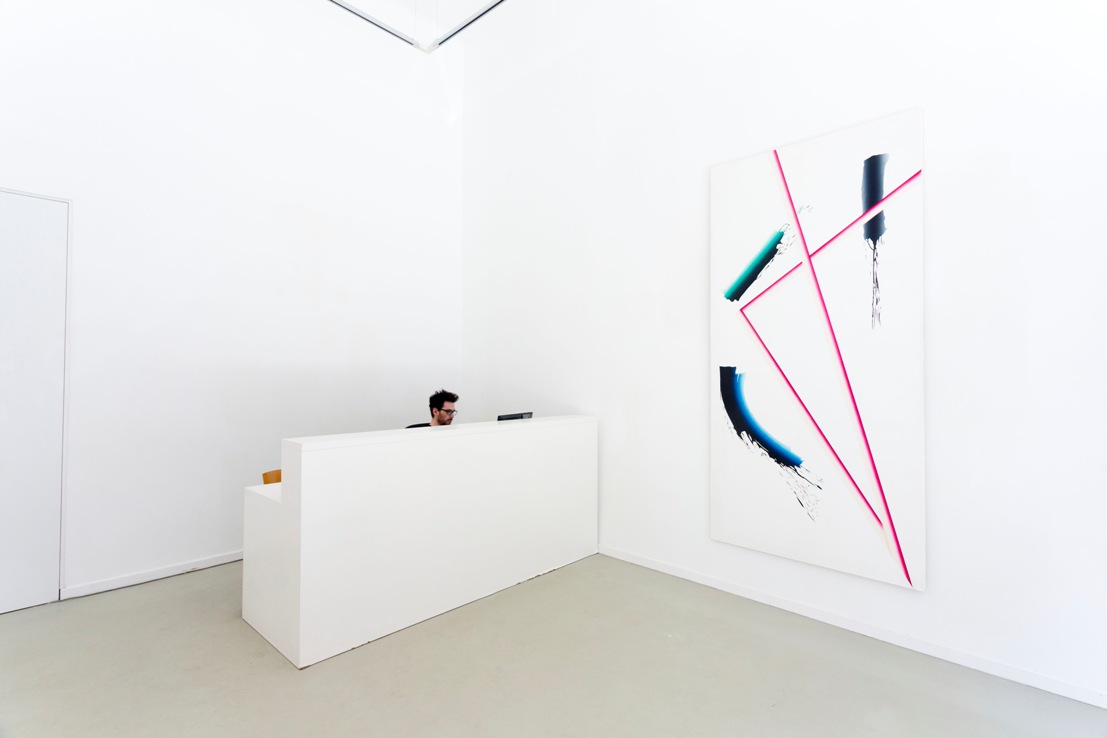


Tamás Hencze
Márton Nemes
Shaping Realities
The Erika Deák Gallery is delighted to announce a new exhibition series, in which we focus on the dialog between artists of different generations. Our first event is a joint exhibition of Tamás Hencze, one of the most important members of the 1968 Iparterv Generation, an internationally known and established painter, and Márton Nemes, an emerging talent of the young, abstract painters’ generation.
The initial idea of this presentation came from the growing demand of young artists seeking for the guidance of their masters. This exhibition is a result of many studio visits and long discussions between the two artists, and while the final selections of presented works came about, a remarkable dialogue was formed between them. Márton Nemes created a new series to this exhibtion, which reflects on Hencze’s art, on his gesture paintings, while keeping his interest in experimentation, and using unusual painting and consturction materials. Hencze exhibits his last, 2014 painting series.
Tamás Hencze was born in Szekszárd in 1938. He lives and works in Budapest and Sáska at the Balaton Uplands. The Kossuth Prize winner artist is a key member of the Hungarian neo-avantgarde art scene and period. His inevitably unique works are included in the largest and most important Hungarian and European collections. Hencze became knows of creating illusory spaces and calligraphic gestures made with the blanking technique.
Márton Nemes was born in Székesfehérvár in 1986. He lives and works in Budapest. He studied at the Department of Painting at the Hungarian Academy of Fine Arts. In 2014, he had a solo exhibition in the renowned the Paks Gallery. His works have been shown in such important places as MSU Zagreb or Künstlerhaus Graz. He also exhibited in Vienna, Berlin, New York. His painting is characterized by continuous experimentation, the extension of genre boundaries, and the pursuit of more formal solutions.
Dávid Fehér arthistorian's opening speech:
The Survival of Painting
Many different things are said and written regarding the crises in twentieth-century and contemporary painting, as well as the present time and fate of the medium, its apparent untimeliness and constant renewal. The latest theories on painting drift between two poles with faith in the autonomy of the medium on one side and coming to a realization regarding the process of immaterialization on the other. Narratives regarding the end and death of painting with a promise of its resurrection are confronted with the increasingly established view that neither perspectives are fully accurate. The question often arises: can pure painting, which is only practiced for its own sake, exist? Painting, for painting, about painting. From a different vantage point, the dilemma becomes whether painting can become its own theory, making itself complete, while also emptying itself. In recent decades, countless transitive concepts of painting have taken shape between the utopistic visions – and extremes – of sensuous revelry and ethereal immateriality, which carried simultaneous tones of affirmation and scepticism. Painting, of course, is not primarily a theoretical activity, but a struggle with the material: with the resistance of dense matter, the interactions of colours, the delicate balance of forms, and the dialectic relationships between movement and motionlessness, between visibility and invisibility, which, while one stands before the artworks (whether completed or still in progress) primarily manifest not as a theoretical dilemma, but as direct, sensuous experience.
Thus, in this regard, it is dangerous business to place the works of Tamás Hencze and Márton Nemes within the complex system of relationships connecting the history and contemporary theories of painting, as such an act will render almost invisible – and even eliminate – the sensuous present reality of the image surface and the dynamics of artistic experimentation aimed at movement, mobilization, and the living painterly gesture. The theoretical-historical context of painting cannot be completely circumvented, however, as a dialogue between juxtaposed paintings can only be realized in this broader context. The presented artworks mutually reflect on and reinterpret one another, thereby creating a boundless dialogue – spanning across generations – on the fate and nature of painting. While the two artists’ points of departure are different, the questions that interest them are practically identical. While Tamás Hencze is a classic, living figure of the Hungarian neo-avantgarde, Márton Nemes is a greatly influential young representative of the post-digitally oriented new abstract tendencies of painting, who, this time around, takes into account the neo-avantgarde traditions of the sixties as well, thereby also paying homage to Tamás Hencze’s incredibly consistent, reductive style of painting.
The beginning of Tamás Hencze’s career is defined by discourses replete with doubts regarding the autonomy and crisis of painting. In a political system that sharply rejected abstraction, he turned toward French informel and American abstract expressionism, and made spontaneous painterly gesture – as an illegible punctuation mark: formlessness solidifying into form – the central motif and element of his painting. Tamás Hencze’s point of departure is the intensity of Pierre Soulages’ gesture painting (which he invoked by name in one of his paintings), on the one hand, and Georges Mathieu’s interpretation of tachisme, on the other. The painterly gesture in Hencze’s early pieces cannot be regarded as entirely autonomous and self-referential, however, since what it actually refers to is the ephemeral act of leaving a mark – it points to movement, mobilization, and action as it occurs in time. A painting is but a dried hand gesture. In 1965, Tamás Hencze, together with Endre Tót, photographed an ironic painterly action: Hencze is standing with an umbrella in hand behind a paint-covered canvas, from which, in the wake of Tót’s animated brush strokes, black paint haphazardly trickles down. Above Hencze’s head, another gesture painting hangs on the wall: that too appears to have paint dribbling down its surface, though it has dried already. Hence stands in the dried paint-rain, reflecting on the duality of motion and motionlessness, liveliness and lifelessness, thereby also emphasizing the performative character of painting.
In the early to mid-sixties, however, the faith in the pure and autonomous painterliness of abstract impressionism seemed to come into question on the international art scene: the world of repeatable forms and reproducible objects gained increased importance over animated and unrepeatable gestures. During this period, Hencze created repetitive structures opening to imaginary depths, using a paint roller. While the illusory nature of these works can be brought into connection with op art and their serial character calls for a parallel with pop art, the sublimely frigid appearance of homogeneous surfaces brings to mind the almost sterile, industrial-looking scenes of post-painterly abstraction. While his early paintings totalized the immediacy of the living human gesture, his later works did away with the accidental and sensuous nature of direct touch. Although it is true that, just like in Hencze’s earlier works, the structures grounded in ethereal transitions of tone thematized the basic questions and phenomena of the motion and mobilization of the material – as is justly pointed out by the artist’s monographer István Hajdu.
In the sixties, Hencze’s art shifted from one extreme to the other: he moved from centralizing and totalizing gesture to making it disappear and eliminating it altogether. The illusory effects of rollered-on surfaces pointed beyond spectacle and materiality, but they did not lead to complete immaterialization – not even in the case of his ethereal fire and smoke paintings, reminiscent of Yves Klein. The duality of showing gesture and then making it disappear was resolved by Hencze in the early eighties: he synthesized, as it were, his two important periods and created his own, “preserved-through-transformation” gesture painting, shaped by stencils and paint rollers, but nevertheless invoking the dynamic of motoric hand movements. Hencze returned to tachisme: he created traditional gesture paintings and then destroyed them. The annihilated gesture paintings, like invisible shells, became stencils or casting moulds for the rollered-on surfaces. This is how direct traces become indirect and a living paint-mark becomes rigidified – but, paradoxically, the sense of dynamism is not lost in the process. The finished painting is created at the cost of the cessation and annihilation of the original gesture.
Hencze rethinks his previous periods with a sense of irony, while also invoking various topoi from the history of abstract painting: his triangularly shaped canvases call to mind Barnett Newman’s sublime colour field paintings. In Hencze’s paintings, the Newmanian “zip” translates as a neon light-like, illusory effect, while the splattering gestures characteristic of tachisme return as torn, roller-applied structures. Hencze’s turn coincided with the emergence of American neo-geo – whose representatives (Ross Bleckner, Philip Taaffe, and others) also put the sublime traditions of American colour field painting in painterly quotation marks, so to speak – just as in Hungary, in parallel to Hencze, such artists as Imre Bak, István Nádler among others, were rethinking, often with a sense of irony, their own painting.
It is as if Hencze were preoccupied with the persistence of painting and the painterly gesture: the relationship between the unrepeatable and the repeatable. He engages in a unique balancing act between the monochromy of hard edge surfaces, the seeming liveliness and actual rigidity of gestures that fill “absence-forms”, while creating pseudo-punctuation marks – not all that foreign to the spirit of Zen – or, as István Hajdu refers to them, “gestograms”. Tachist Geometry is the title of one of Hencze’s paintings from 1987, which could easily be read together with Imre Bak’s Geometric Calligraphy series, since, in both cases, fundamentally opposite qualities are brought into contrast. Hencze sets geometry and calligraphy – form that is ab ovo given and form that occurs by chance – against one another. Behind, between and next to the plank-like, illusorily shaded, seemingly bending segments that form a triangle, ragged gestures emerge – or, more precisely, it is not even the actual gestures or smudges of paint that appear, but the traces they have left behind.
It is as if the forms written on the blank image base were rethinking Wassily Kandinsky’s classic questions about points, lines and planes, while also calling to mind, with some irony, the topoi of op art and tachisme. French art historian Yve-Alain Bois referred to the artists of the neo-geo as “manic mourners”, since their irony questioned the pathos-laden faith in painting and in the utopias attached to modernism.
Hencze’s paintings similarly question the myths of uniqueness and unrepeatability. In Purple Diptych, he juxtaposes gesture and gesture-negative, presence and absence, form and counter-form. All the while, in the dialectical image-pair, a reminiscence of Barnett Newman’s almost sacred “zip” returns as a phenomenon of ethereal light, inscribed, as it were, onto a calligraphic composition, which also carries the legacy of Dezső Korniss.
During this recent period, Hencze has often given his works the title Organic Gesture: it as if the living-lifeless pseudo-patches of paint, which are sometimes confronted with homogeneous colour fields, were examining the painterly gesture – preserved as it is through transformation – and, in the figurative sense, the survival of painting itself.
Márton Nemes joined the discourse on the survival of painting at a later point in time. It is from a considerable historical distance that he views not only abstract expressionism, tachisme, op art and pop art, but neo-geo as well. He looks upon not only end-narratives, but the announcement of the end of end-narratives, as a phenomenon of the past. At the beginning of his career, he took the New Leipzig School as his starting point, but the visual language of post-socialist figural painting soon gave way in Nemes’ art to the world of new abstraction, which also resonates with digital visual culture. Márton Nemes belongs to the generation of painters whose American representatives were presented by the MoMA in 2014 in an exhibition entitled The Forever Now. The atemporal experience of an endless present time, as suggested by the title, alludes to the verbal and visual information that appears side by side in an endless torrent on the internet. It is in accordance with this that the widest range of art-historical references and temporal layers are intimated in Nemes’ art: the sometimes agitated, at other times almost frozen, gestures of abstract expressionism, and the monumental, homogeneous surfaces of colour field painting (like, for instance, Mark Rothko’s compositions comprised of soft blotches of paint that appear to almost form landscapes). The décollage of the French affichistes, created from torn-up posters, show up in Nemes’ painting, not as a collage surface, but as a painterly structure shaped in a trompe l’oeil-like manner. At other times, these are also accompanied by elements reminiscent of Simon Hantai’s pliage. While post-painterly abstraction – whose representatives include Imre Bak, István Nádler and Tamás Hencze, among others – constitutes an important antecedent to Márton Nemes’ art, his key references are not primarily local. His works are more akin to the new abstract endeavours of recent years and decades: the art of Katharina Grosse, Thomas Scheibitz, Oscar Murillo, Sterling Ruby, Wade Guyton, Kelley Walker, Imi Knoebel and others, who can be regarded as defining influences in terms of the Hungarian representatives of painting after technology, such as Róbert Batykó, Gergő Szinyova, and Gábor Kristóf.
Moving away from the panel painting format has become an increasingly important question in Nemes’ art recently: in addition to presenting his paintings as parts of a single total installation during his solo exhibition at Art Gallery Paks, in his most recent works, he attempts to deconstruct the framework – and framework systems – of panel painting, in the most literal sense of the word. In his new works, the canvas as support is often traded for defective banners (Printing Waste). The painted surface comes into interference with the printed visual fragment, calling to mind Robert Rauschenberg’s compositions built on the dialectic of silkscreen printed surfaces and painterly gestures, as well as Albert Oehlen’s painting series which transcribes printed image fields onto sensuous paintings. While, previously, Nemes aimed to destroy and deconstruct the topoi of modernist form-creation on his acryl- and airbrush-painted surfaces, in his latest series, he reflects on the questions of knowableness and explores the nature of painting after technology.
Márton Nemes gave his latest series the title Temporary Images. While transitoriness may be an obvious reference to the movement of continuously circulating, altering, and shifting images, it also concerns the structure of the artworks. Nemes cuts panel paintings into pieces, reassembles them, and then uses ratchet straps to fix the resulting work in place, while maintaining his options for later modifications. The panel painting stops functioning as such and loses its definitive character. The ratchet strap motif – which can also be seen in the works of such artists as Matias Faldbakken, Jose Dávila and Morgan-Richard Murphey – refers to shipment, packaging and a state of transit. This emphatically commonplace motif appears to blur the boundaries of everyday visual culture and visual art. (Nemes’ activities in the fields of fashion and design also speak to this ambition.) The picture panels held together by the ratchet strap resemble block-boards, also resonating with Imi Knoebel’s environments invoking the bricolage aesthetic. On the boards, differently worked surfaces are juxtaposed: some fields bring to mind Nemes’ earlier, expressive paintings and frozen gestures, while others are covered with car enamel. The surface of the enamel changes in accordance with the angle of incidence of light; it glimmers iridescently, creating an almost ethereal effect, also invoking the world of industrial design. The forms are industrial and sterile, just like László Moholy-Nagy’s similarly enamelled telephone paintings.
The most complex piece of the Temporary images series, at least up to this point, is a diptych entitled Theseus. Nemes splits two panels into identical elements, and then takes these to create an identically composed, but differently structured, constellation. He paints the surface of image fragments with various types of white industrial paint: rough-textured wall paint, shiny enamel paint, and white household paint, calling to mind the smooth surfaces of block-boards. In both cases, the panels are held together by ratchet straps, on which fragments of Nemes’ earlier paintings and photos run across like film strips. The oversaturated borders are confronted with the emptiness of the white surfaces. To paraphrase the Hungarian poet Attila József, one board holds, presses, clutches the other to itself, uniquely balancing between fragmentation and the visual unity that is constructed from it. Nemes builds on the play of nuanced and subtle factural differences. His unfilled, empty image fields appear as paintings waiting to be painted. The monochromes mark the boundaries and possible endpoints of painting, thereby bringing to mind not only Alexander Rodchenko’s monochromic, primary-coloured panel paintings, but Robert Rauschenberg’s White Paintings from 1951 as well, which were also composed of multiple panels and created with industrial paint. Rauschenberg described these works as “organic silence, the restriction and freedom of absence, the plastic fullness of nothing”. These paintings, filled with a suggestive emptiness and carrying an almost sacred aura, were not only imbued with the lessons learned from the abstract painting of Josef Albers (a teacher at Black Mountain College), but also invoked Kazimir Malevich’s white square floating in a white background. “I wanted to see how much I could take away from an image and still have an image” – stated Rauschenberg, whose white-on-white paintings thematized a kind of border experience, just as John Cage’s 4’33’’ did, which – as Branden W. Joseph pointed out – was not independent from Rauschenberg’s painting series.
Nemes confronts the visual noise printed on the ratchet straps with the suggestive silence of white-against-white surfaces. Paradoxically, the most image-like aspect of the work is not the image itself, but the wrapping material, while the white panels held together with the straps seem more like byproducts of the construction industry, just as Guyton\Walker’s installations. This time, Nemes doubles up the composition, thereby creating a dialectic image pair. He makes a reference to the dilemma of Theseus’ ship: if a ship has all of its components replaced – and its old components are used to perhaps build a new ship – is it still identical to itself? While Nemes explores the identity of image constructions built from identical elements, he also raises the problematic of painting and non-painting, of image and non-image. Ultimately, he thematizes the identity of the image in the age of post-technology, when – to quote David Joselit’s renowned essay – painting is beside itself.
The image-pair also invokes Tamás Hencze’s diptych structures. As, in connection to Hencze’s Purple Diptych and other serial compositions, the question arises: is it possible to create two perfectly identical forms, and, if yes, can the two truly be the same? To what extent is the unrepeatable repeatable (we can refer here to Robert Rauschenberg’s paired paintings Factum I-II). This is a question not only for the age of technological reproducibility, but for the post-digital world as well, in which such concepts as original and copy, in effect, lose their meaning. Hencze and Nemes are both seeking answers to the basic questions of painting in the age of post-technology. In their snow-white image fields, they not only explore the phenomena of material-in-motion and the possibilities for causing such motion, but also model the shifts in the concept of painting.
On View: 2017. 04. 14. - 08. 30.